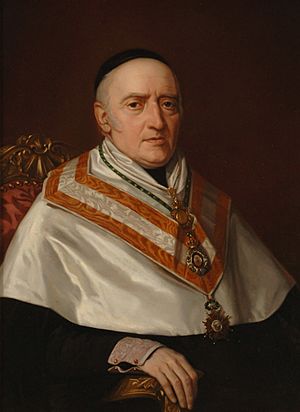Juan Nicasio Gallego facts for kids
Quick facts for kids
Juan Nicasio Gallego
|
|
|---|---|

Portrait by Luis de Madrazo
|
|
| Born |
Juan Nicasio Gallego
14 December 1777 Zamora, Spain
|
| Died | 9 January 1853 (aged 75) Madrid, Spain
|
| Seat Q of the Real Academia Española | |
| In office 1833 – 9 January 1853 |
|
| Preceded by | Antonio Porcel Román |
| Succeeded by | Antonio Ferrer del Río |
Juan Nicasio Gallego was an important Spanish priest and poet. He was born in Zamora, Spain, on December 14, 1777. He passed away in Madrid on January 9, 1853.
Contents
A Poet and Patriot
Juan Nicasio Gallego studied in Salamanca, a city in Spain. After becoming a priest, he moved to Madrid. There, he got a job at the royal palace, where he managed the royal pages.
Gallego was a strong patriot who loved his country. He also enjoyed a style of writing called pseudo-classicism. This style looked back to ancient Greek and Roman art for inspiration. He joined a group of writers who admired the poet Manuel José Quintana. Gallego often copied Quintana's writing style.
Gallego is best known for only a few of his poems. These include seven odes and elegies. An ode is a poem that praises something, and an elegy is a sad poem, often for someone who has died.
Early Works and Patriotism
One of his first famous poems was an ode called A la defensa de Buenos Ayres. He wrote it in 1807. This poem was against the British invasions of the Río de la Plata. These were attempts by the British to take over parts of South America.
Another well-known poem was an elegy. He wrote it after the Duchess of Frias died.
Political Life and Challenges
Gallego had strong liberal ideas. This meant he believed in more freedom and rights for people. Because of these beliefs, he ran for election and became a deputy. A deputy is like a representative in the Spanish parliament, called the Cortes Generales.
Gallego strongly opposed Napoleon's invasion of Spain. He spoke out and wrote against it. However, when King Ferdinand VII returned to power in 1814, he was a very strict ruler. He had Gallego put in prison because of his liberal views.
Later, during a time when Spain had a new constitution, Gallego was set free. He was then appointed as an Archdeacon in Valencia. An archdeacon is a high-ranking church official.
Royal Spanish Academy
The Royal Spanish Academy is a very important group in Spain. It works to protect and improve the Spanish language. They invited Juan Nicasio Gallego to become a member. He was even made their permanent secretary.
El Dos de Mayo
The most famous poem by Gallego is the elegy El Dos de Mayo. This poem remembers the brave events of May 2, 1808. On that day, a few hundred Spanish civilians and soldiers rebelled in Madrid. This was against Napoleon's forces who had invaded Spain.
Important figures in this uprising included artillery captains Daoiz and Velarde. An infantry lieutenant named Ruiz was also part of it. This revolt in Madrid inspired people all over Spain to rise up against Napoleon. Gallego's powerful words encouraged his countrymen to fight until the end. His poem is said to have had a huge impact on the Spanish people.
See also
In Spanish: Juan Nicasio Gallego para niños

